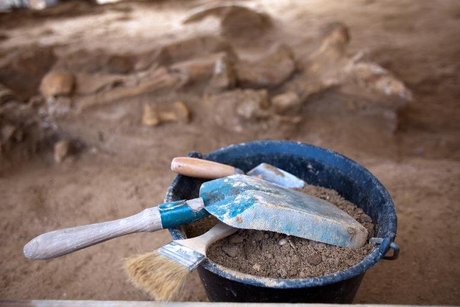Earliest Tools Dated to 3.3 Million Years Ago

Anthropologists said Wednesday that stone tools found in northwest Kenya dating back 3.3 million years challenge the mainstream story of mankind.
The tools are an astonishing 700,000 years older than the first known implements, which have been attributed to Homo habilis, a forerunner of modern humans.
"The tools we have unearthed are the very first fossil traces of techniques bequeathed by our hominin ancestors 3.3 million years ago," French researcher Sonia Harmand, of New York's Stony Brook University, told Agence France Presse.
"Our discovery also refutes the long-standing theory that Homo habilis was the first maker of tools."
Tool-making, like fire-making and farming, is considered a key moment in the ascent of humans.
The theory is that tools emerged to help hominins -- the term for modern and extinct species of humans -- butcher animals, unlocking protein that in turn helped the evolution of bigger brains.
But crafting a tool, by hitting a stone with another stone, requires conceptual and motor skills.
Until now, these were thought to be beyond the ape-like hominins who lived before H. habilis, whose "handy man" name comes from his apparent dexterity.
Habilis, bigger-brained than previous hominins, is an ancestor of Homo sapiens who lived between roughly 2.8 and 1.5 million years ago. The earliest tools in the Habilis era date from around 2.6 million years ago.
The tool discovery was made in the Nachukui Formation, a remote site in scrublands west of Lake Turkana that has yielded a series of remarkable finds since the mid-1980s.
It came through a stroke of luck, when Harmand and her colleague Jason Lewis went on a scouting trip one morning in July 2011 and got lost.
Seeking their way back, they climbed a hill to get a better view and got a strange feeling "that something was special about this particular place."
With the help of a local tribesman, they explored craggy outcrops which yielded the first of these ancient treasures.
The haul, described in the journal Nature, comprises 149 artifacts, from stone cores and flakes to rocks used for hammering.
Compared with later stone tools they are primitive, but they could have poked and crushed bones to tease out marrow, or bashed open nuts or dead tree trunks to get at grubs and insects, the scientists believe.
The stones were found just above a layer of volcanic ash dated through argon isotopes to about 3.3 million years ago.
This estimate was confirmed by measuring telltale shifts in Earth's magnetic fields in iron-bearing minerals in sediment where the tools were found.
Other members of the team looked at carbon isotopes in the soil, which together with animal fossils at the site enabled them to get an idea of the vegetation at the time.
They were surprised to find that whereas the landscape in western Turkana today is desert-like, more than three million years ago it was shrubby and partially-wooded.
- Mystery toolmaker -
The big question is: who made the tools?
One possibility: an as-yet unknown member of our own Homo lineage, who would have walked the planet hundreds of thousands of years before Habilis.
Another possibility: smaller-brained hominins that, at best, were distant cousins of Homo.
One candidate is called Kenyanthropus platyops, of which a tooth and bone from a skull were found in 1999 just a kilometre (half a mile) or so from where the stones were found.
Another is Australopithecus afarensis -- made famous by the fossil known as Lucy -- which lived relatively nearby around 3.3 million years ago in what today is Ethiopia's Lower Awash Valley.
Even if the toolmakers are for now unidentified, the scientists say they were surprisingly smart.
The tools should prompt a rethink of when hominins evolved key features of the brain and nervous system, they said.
"Their makers' hand motor control must have been substantial," the study said.
Changes to the spinal cord and expansion of the cerebral cortex and the cerebellum "could have occurred before 3.3 million years ago."



